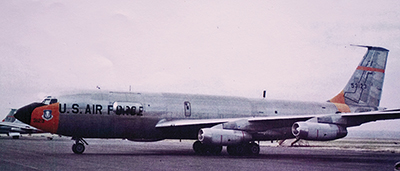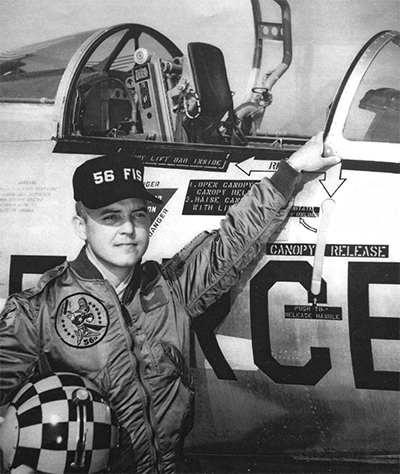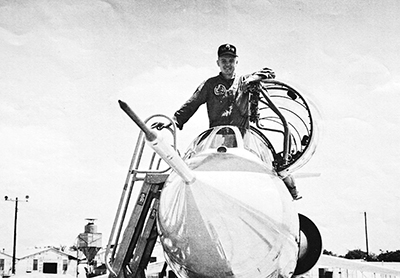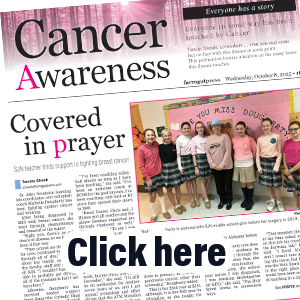Fearless innovator
Farragut resident Charles Doty’s incredible military flying career includes combat tours, training astronauts — plus groundbreaking work in Oak Ridge
Few if any military heroes were as versatile, serving so many critical roles in service to his country, as Retired Air Force Lt. Col. Charles Doty of Farragut.
On top of his groundbreaking and innovative expertise in matters of flying and aircraft knowledge, which benefitted the U.S. Air Force, U.S. Navy and U.S. Army — in addition to tours of duty flying missions over North Vietnam — “I was the Zero Gravity Test Director: I trained the astronauts,” said Charles, 89, during a recent interview.
“… I had 15 guys working for me. I had known all those astronauts because I had been flying with them before,” he added. “It was a full, kind of personal, program.”
Moreover, “One of my good friends — an astronaut — and I were the primary designers for the moon lander,” Charles said.
And, along the way, “I saved a couple of lives,” he said.
What’s more, “I flew special missions for foreign governments,” which included U.S. allies “Canada and Israel. … I’m a veteran of the ’67 (Israel versus Egypt, Jordan and Syria in the Six-Day) War,” he said. “I taught the Israelis how to fly.”
As for his combat flights in Vietnam, “I flew across Hanoi at 50 feet at 600 knots,” Charles said.
Here’s another topper: “I am the only pilot in the Air Force, to my knowledge, that has ever flown an aircraft blind,” Charles said. “What they did was, they wanted an experimental person to fly aircraft in rain, bad weather. I was flying with canvas covers on the front end.”
As opposed to using the term “dangerous,” Charles instead said, “It was an experience that really was exciting.”
Drawing upon that experience, “I was the guy that flew in all of the bad weather to collect the weather data for the Air Force and for the government,” Charles said. “I flew through thunderstorms, I flew through everything — you name it.”
Running a simulation training program for the Air Force, “The commanding general, he (ordered) me to go to Wright Field (Ohio),” Charles said. “And in Wright Field what I did was… I was sent to a base (in Canada). I commanded 15 aircraft that (in simulation) attacked the United States for two weeks.”
Doing almost too good of a job “attacking” Chicago and Detroit, he added, “I can tell you we won.
“After that I became one of the experimental flight-test pilots.”
Not to leave out another mode of military flight, “I flew the Army helicopters and wrote the textbook on them, the Chinook and the Huey,” Charles said. “Both of those were my products.”
Early on, “My initial flights were with the Air Force teaching B-47 pilots how to fly,” Charles said. “… By that time I had flown F-84s and others.”
A testament to Charles’ level of training for these pilots can be summed up in a simple phrase: “I can tell you I did not lose a pilot; I’m so proud of that,” he said. “I came up with new tactics and techniques that the Air Force had never done before.”
However, “they decided they didn’t want me there; they wanted me in another place. So they pulled me from B-47 instruction,” he added.
As a sort of “test pilot,” Charles said he “ended up flying aircraft that were having problems (for) the Navy. I wrote a book on that.”
Saying he “worked for two Presidents” while “in Washington for 10 years,” Charles also said his duties included “flying all the VIPs.”
Specifically, “I flew President (Lyndon B.) Johnson’s family,” he added. “I spent a lot of time in the White House.”
About moving to what is now Farragut in 1975, Charles said he “turned down” a promotion to colonel, instead choosing to become a “lieutenant colonel and (work in) Oak Ridge,” he said.
“I became one of the senior managers at Oak Ridge (National Laboratory),” he added, to help solve “a problem they couldn’t fix” anywhere in the nation.
Charles said he had “a little over four weeks to come up with a plan” to solve that problem: “how to measure uranium in the United States.
“I became commander of 25 people, contractors, that were out there … and we won,” he added, beating Los Alamos, New Mexico and two other selected scientific areas in the country also working on the issue.
“I figured out how to do it in a week.”
In Blount County, “I was flying F-86Vs and 86Ls. I was the senior commander for all of the training — I trained all of the pilots over at McGhee Tyson Airport,” he said. “I flew about everything you could fly over there.”
He was also “commander of a program that was put in by Major Command out west, and the objective was to get an A-Award for the base,” Charles added. “I can tell you truthfully that right here, at (McGhee Tyson) Airport, was the first aircraft unit to be able to have an A-Award.
“We were the very first people that ever did that. It was really exciting.”
While a tennis letterman at the University of Tennessee for two years, “I wound up with five degrees,” he said. “They were spread all over the country, and sent and paid for by the government.”
It was at UT where Charles met his eventual wife of 67 years, the late Norma Doty — herself an accomplished musician, as a “member of the National Symphony,” and artist.
“And she raised three children well,” he added.
Charles labeled Farragut “a wonderful Town,” adding he and Norma “were just tickled to death to be here.”







